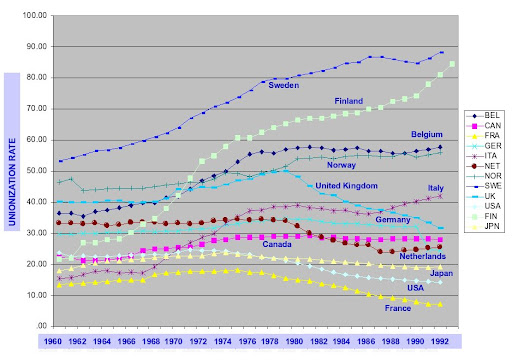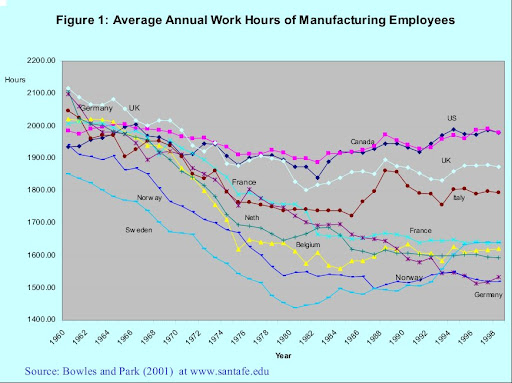Saturday, June 14, 2008
Russ Roberts and Unions
Posted by Simon Halliday | Saturday, June 14, 2008 | Category:
Labour Economics,
Microeconomics,
Roberts,
Unions
|
I was listening to this podcast (April 2008) from EconTalk where Russ Roberts (he and Don Bordreux blog at Cafe Hayek) provides his theories about jobs, unionization, inequality and the stratification of the economy. I will comment solely on his argument about unionization.
He argues that unionization rates in the United States dropped on account of the movement away from labour intense work, such as manufacturing and agriculture. He argues that they had moved from this into industries in which there wasn't as much of a need for unionization (lack of harsh conditions, etc), such as the service industry.
 So that, in and of itself, isn't an unconvincing argument. So I went and
So that, in and of itself, isn't an unconvincing argument. So I went and
looked at one of my textbooks to see if I could find anything about
unionization rates. Lo and behold (and quite serendipitously), one of
the problem sets that I was doing as part of my prep for an exam includes a graph about unionization in OECD countries. Shown adjacent (courtesy Bowles, 2006 from Luxembourg Income Survey Data). (aside: Roberts also argued that the change began in the 50s, I don't have data on that period).
Now if the assertion that a shift to services, which Roberts asserts drove the change, and which has occurred in most of the OECD countries is 'the reason' behind the de-unionization of the US then this de-unionization should occur throughout the OECD. If not, then not. (Note I am struggling to find a paper/data on this change cross country, looked at some data from the OECD factbook).
Which begs the question, what are the real reasons? Were I a better labour economist than I am, I could probably tell you in detail. What I can talk about is one of the models that we looked at in the course was a behavioural updating model in which you would expect a priori for there to be local homogeneity and global heterogeneity in the distribution of some trait in which there are certain empirically observable characteristics and which the model can replicate (depending on parameter values), in the case of this study the trait union density. What does this mean? With certain starting conditions, and certain random perturbations, or alterations in institutional setting (acceptability of being in a union say, or lack of union-breaker politicians such as Thatcher and Reagan) you would expect there to be differences in the distribution of unionization, even if countries started at relatively similar starting points, i.e. the divergence we observe in the graph above. Things like culture, politics and historical contingency (path dependence) enter as a factors into these models, which, for me, gives them more flavour, but which for others could be problematic.
I will give a technical analysis of it in a couple of days time if anyone is interested. If so, get ready for some LaTex2html...
Please note that the model is not meant to 'explain' unions and unionization, but is intended instead as a description of what could be a reason (given institutional setup and other factors) and to which Roberts' point could be a contributor. I just don't believe that his argument holds water as the sole explanation in the face of the data.
Edit: I found another graph that could be interesting in the context of the above.

He argues that unionization rates in the United States dropped on account of the movement away from labour intense work, such as manufacturing and agriculture. He argues that they had moved from this into industries in which there wasn't as much of a need for unionization (lack of harsh conditions, etc), such as the service industry.
 So that, in and of itself, isn't an unconvincing argument. So I went and
So that, in and of itself, isn't an unconvincing argument. So I went andlooked at one of my textbooks to see if I could find anything about
unionization rates. Lo and behold (and quite serendipitously), one of
the problem sets that I was doing as part of my prep for an exam includes a graph about unionization in OECD countries. Shown adjacent (courtesy Bowles, 2006 from Luxembourg Income Survey Data). (aside: Roberts also argued that the change began in the 50s, I don't have data on that period).
Now if the assertion that a shift to services, which Roberts asserts drove the change, and which has occurred in most of the OECD countries is 'the reason' behind the de-unionization of the US then this de-unionization should occur throughout the OECD. If not, then not. (Note I am struggling to find a paper/data on this change cross country, looked at some data from the OECD factbook).
Which begs the question, what are the real reasons? Were I a better labour economist than I am, I could probably tell you in detail. What I can talk about is one of the models that we looked at in the course was a behavioural updating model in which you would expect a priori for there to be local homogeneity and global heterogeneity in the distribution of some trait in which there are certain empirically observable characteristics and which the model can replicate (depending on parameter values), in the case of this study the trait union density. What does this mean? With certain starting conditions, and certain random perturbations, or alterations in institutional setting (acceptability of being in a union say, or lack of union-breaker politicians such as Thatcher and Reagan) you would expect there to be differences in the distribution of unionization, even if countries started at relatively similar starting points, i.e. the divergence we observe in the graph above. Things like culture, politics and historical contingency (path dependence) enter as a factors into these models, which, for me, gives them more flavour, but which for others could be problematic.
I will give a technical analysis of it in a couple of days time if anyone is interested. If so, get ready for some LaTex2html...
Please note that the model is not meant to 'explain' unions and unionization, but is intended instead as a description of what could be a reason (given institutional setup and other factors) and to which Roberts' point could be a contributor. I just don't believe that his argument holds water as the sole explanation in the face of the data.
Edit: I found another graph that could be interesting in the context of the above.

Subscribe to:
Post Comments (Atom)




Currently have 0 comments:
Post a Comment